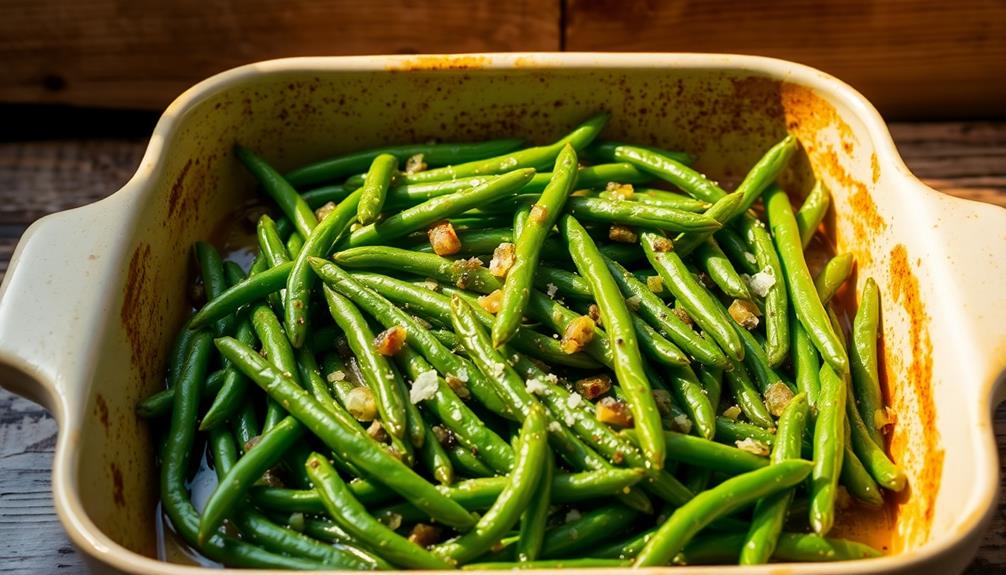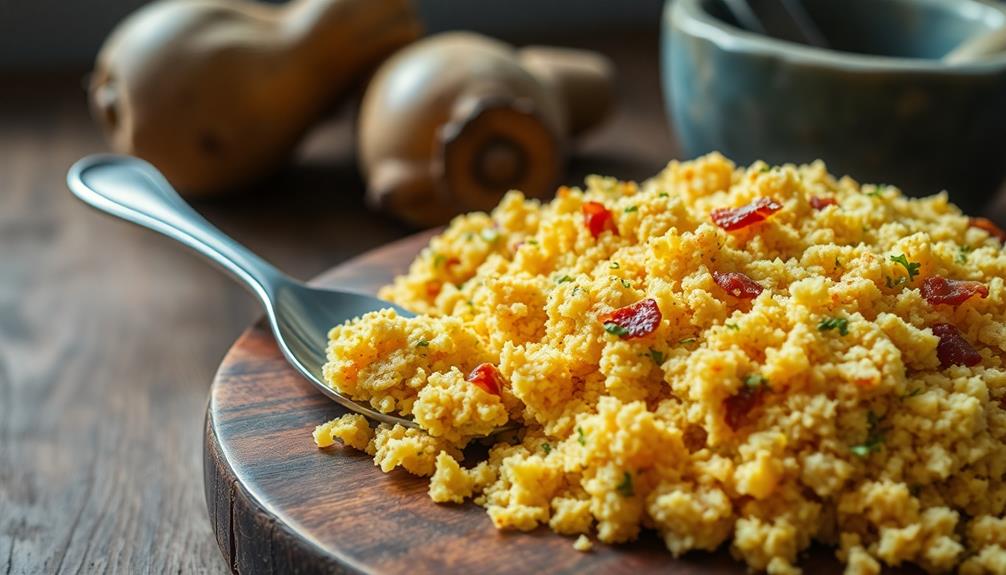Caruru is a beloved Brazilian stew that blends the rich heritage of indigenous, African, and Portuguese traditions. This hearty dish stars okra, dried shrimp, and fragrant spices, creating a flavor-packed, comforting meal. Start by sautéing the okra to reduce its natural "slime," then simmer it with juicy tomatoes, aromatic onions and garlic, and toasted peanuts for a creamy texture. Season with cumin, coriander, and cilantro for an authentic taste. Caruru is a true celebration of community and family – you'll want to dive right in and discover more about this cherished regional cuisine.
Key Takeaways
- Caruru is a traditional Brazilian dish originating from Afro-Brazilian culinary traditions, reflecting a fusion of indigenous, African, and Portuguese influences.
- The dish is a hearty stew primarily consisting of okra, tomatoes, dried shrimp, and ground peanuts, often served as a main course or side.
- Key ingredients in caruru include okra, for its distinctive texture, dried shrimp for protein, and toasted ground peanuts for creaminess and richness.
- Caruru is celebrated as a quintessential Brazilian delicacy, representing Afro-Brazilian culture and the importance of heritage and family recipes.
- Caruru offers a unique blend of flavors and textures, making it a comforting and engaging dish for those seeking authentic Brazilian culinary experiences.
History
The origins of caruru can be traced back to the indigenous cultures of Brazil. This flavorful dish has been enjoyed for generations, with its roots firmly planted in the country's rich culinary heritage.
Over time, caruru has evolved, blending traditional recipes with influences from Africa and Portugal, creating a truly unique and delectable experience.
As you delve into the history of this beloved dish, you'll find that it's not just a meal – it's a celebration of Brazil's diverse cultural tapestry. The use of okra, a key ingredient in caruru, is a testament to the plant's deep significance in the region's cuisine.
The dish's vibrant colors and aromatic spices reflect the vibrancy and diversity of the people who've passed down this culinary tradition.
Whether you're a seasoned caruru enthusiast or a curious newcomer, exploring its history is a delightful journey that will leave you with a deeper appreciation for this quintessential Brazilian delicacy.
Recipe
Caruru is a traditional Brazilian dish originating from the northeastern region of the country. It's a hearty and flavorful stew made with okra, tomatoes, and a variety of spices.
The dish is often served as a main course, but it can also be enjoyed as a side dish. The combination of the tender okra, the tangy tomatoes, and the aromatic spices creates a delightful and unique taste experience.
Ingredients:
- 1 lb okra, sliced into 1-inch pieces
- 2 medium tomatoes, diced
- 1 onion, diced
- 3 cloves garlic, minced
- 2 tablespoons palm oil or vegetable oil
- 1 teaspoon ground cumin
- 1 teaspoon paprika
- 1/2 teaspoon cayenne pepper
- Salt and black pepper to taste
- 2 cups water or broth
Instructions:
In a large pot or Dutch oven, heat the palm oil over medium heat. Add the onion and garlic, and sauté until translucent.
Add the okra, tomatoes, cumin, paprika, cayenne, salt, and black pepper. Stir to combine.
Pour in the water or broth, and bring the mixture to a boil. Reduce the heat to low, cover, and simmer for 20-25 minutes, or until the okra is tender and the flavors have melded together.
Tips:
For a richer flavor, you can add a small amount of tomato paste to the stew.
Additionally, some recipes call for the addition of shrimp or other proteins to make the dish more substantial.
Serve the caruru over rice or with crusty bread to soak up the delicious broth.
Cooking Steps
First, you'll want to rinse the okra thoroughly to wash away any dirt or debris.
Then, slice the okra into bite-sized pieces for even cooking.
Next, sauté the sliced okra in a bit of oil until it's nicely browned.
Step 1. Rinse the Okra Thoroughly

Rinsing the okra thoroughly is a crucial step in preparing this versatile vegetable.
You'll want to give those little green pods a good wash under cool running water. This helps remove any dirt, debris, or pesticide residue that may be lingering on the surface.
Don't be shy – gently rub each piece with your fingers to dislodge any stubborn grime. Once they're squeaky clean, you can pat the okra dry with a paper towel or clean dish cloth.
Getting rid of excess moisture will help the okra brown and caramelize beautifully when you cook it later. Plus, a dry surface means the spices and seasonings you add will cling perfectly.
With the okra all nice and clean, you're one step closer to enjoying a delicious, homemade batch of caruru. Just wait until you taste how the flavors pop! You can really enhance the flavors of the caruru by adding some shrimp and diced tomatoes. For an extra kick, consider adding a little bit of chili pepper. Once everything is cooked together, you’ll have a mouthwatering dish that will have you coming back for more. And for a sweet ending, try making my favorite sweet coconut candy recipe. It’s the perfect way to end your meal on a high note!
Step 2. Slice Okra Into Bite-Sized Pieces

With the okra rinsed and dried, it's time to start cutting. Grab a sharp knife and carefully slice each okra pod into bite-sized pieces. Be sure to cut them evenly, so they cook at the same rate.
Don't worry if they're not perfectly uniform – the delightful, crunchy texture is what really matters! As you work, try to make the slices around a half-inch thick. This size is just right for soaking up all the tasty flavors in the dish.
If the pods are particularly long, you can slice them in half lengthwise first, then cut across to create those perfect little coins. Isn't it fun to watch the okra transform from long and skinny to these adorable, ready-to-cook morsels?
With the cutting done, you're one step closer to enjoying this delightful Caruru. Keep up the great work – the best is yet to come!
Step 3. Sauté Sliced Okra in Oil

After slicing the okra, it's time to sauté the pieces.
Heat a skillet over medium heat and add a few tablespoons of oil. Once the oil is hot, carefully add the sliced okra. Don't overcrowd the pan – work in batches if needed.
Sauté the okra, stirring occasionally, until it starts to brown and become tender, about 5-7 minutes.
The key is to let the okra sizzle and get a nice caramelized edge, which helps reduce its sometimes-slimy texture. As the okra cooks, you might notice it releasing some liquid. That's okay – just keep cooking until the liquid evaporates and the pieces become nicely browned.
Once the okra is cooked to your liking, season it with a pinch of salt and pepper. You can also add a squeeze of lemon or a sprinkle of your favorite spices for extra flavor.
Serve the sautéed okra warm, and enjoy its delightful crunch and delicate taste.
Step 4. Add Tomatoes

To add tomatoes, simply toss the sautéed okra with chopped or diced tomatoes. The juicy, vibrant tomatoes will add a lovely burst of flavor to the dish. You can use any type of tomato – cherry, Roma, beefsteak, whatever looks best at the market. Just chop them into bite-sized pieces so they integrate nicely with the okra.
Next, gently fold the tomatoes into the sautéed okra until they're evenly distributed. The tomatoes will release their juices, creating a delicious sauce that coats the okra. This extra moisture also helps soften the okra even further, making for a wonderfully tender and flavorful final dish.
Feel free to season with a pinch of salt and pepper, or any other spices you enjoy. The tomatoes and okra are a classic pairing, so you really can't go wrong.
In just a few simple steps, you've taken your sautéed okra to the next level!
Step 5. Add Seasonings

Once you've added the juicy tomatoes, it's time to season the dish. Now's the chance to really make those flavors pop!
Start by sprinkling in some vibrant, earthy cumin. This warm spice will lend a lovely depth to the caruru. Don't be shy – go ahead and add a good pinch or two.
Next, grab that bottle of paprika and give it a generous shake. The paprika will infuse the dish with a delightful smokiness that complements the tomatoes beautifully.
Now, for a touch of zing, squeeze in the juice of half a lime. The citrusy notes will help balance out the other seasonings. Can you already smell those incredible aromas wafting through your kitchen?
To finish things off, tear in some fresh cilantro leaves. Their vibrant, herbaceous flavor will tie everything together in the most mouthwatering way.
Stir it all up, take a deep breath, and get ready to enjoy your perfectly seasoned caruru!
Final Thoughts
With the dish's rich history and cultural significance explored, it's clear that caruru is a cherished part of Afro-Brazilian cuisine. Caruru, a flavorful stew made with okra, onions, shrimp, and palm oil, has been enjoyed for generations in Brazil. Its roots in West African cuisine are evident in the use of palm oil and okra, both common ingredients in traditional West African dishes. Additionally, the influence of traditional South African dried meat, known as biltong, can be seen in the preservation methods used in Afro-Brazilian cuisine. The cultural exchange and blending of flavors in caruru make it an important symbol of the diverse and vibrant Afro-Brazilian culinary tradition.
You've learned all about its vibrant ingredients, traditional preparation, and the important role it plays in celebrating Afro-Brazilian identity.
Now, it's time to reflect on why this classic dish should be on your must-try list.
Caruru's complex flavors and textures make it a truly unique culinary experience.
The blend of okra, shrimp, and aromatic seasonings creates a dish that's both comforting and absolutely delicious.
Plus, preparing caruru is a fun and engaging process that the whole family can enjoy together.
Whether you're exploring new flavors or reconnecting with your heritage, giving this iconic recipe a try is sure to be a highlight.
Frequently Asked Questions
How Long Can Caruru Be Stored?
When it comes to storing food, the duration depends on the item. With proper storage conditions, you can typically keep it fresh for several days. However, it's always best to check the item's specific storage guidelines.
Is Caruru Gluten-Free?
Yes, caruru is gluten-free. Most green leafy vegetables, like caruru, don't contain gluten, which is a protein found in certain grains. So, you can safely enjoy caruru if you have a gluten intolerance or celiac disease.
Can Caruru Be Frozen for Later Use?
Yes, you can freeze caruru for later use. The dish freezes well, allowing you to prepare it in advance and reheat it when needed. Just be sure to store it properly to preserve its flavor and texture.
What Type of Onions Work Best for Caruru?
When making caruru, you'll want to use sweet onions like Vidalia or Walla Walla. These types have a milder flavor that won't overpower the other ingredients. Red or white onions can work too, but the sweetness of the former is ideal.
Is Caruru Suitable for Vegetarians or Vegans?
Yes, caruru is suitable for vegetarians and vegans. The dish is made with a variety of vegetables and does not contain any animal products, making it a great option for those following a plant-based diet.










